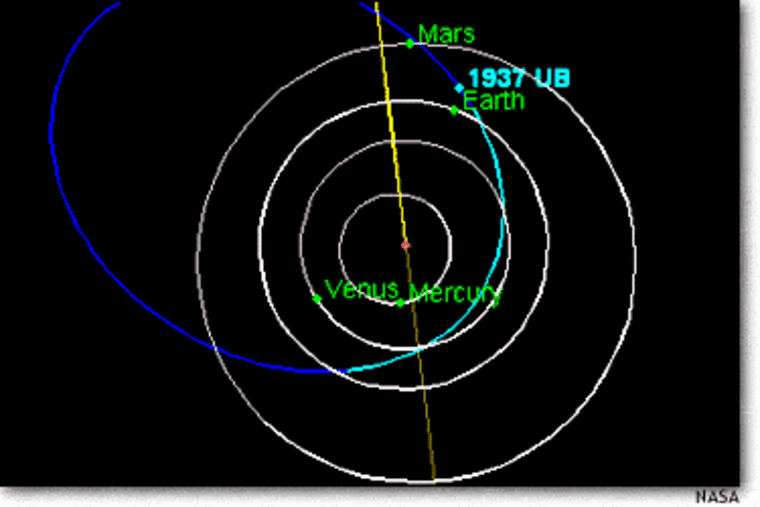Astronomers have apparently discovered an interesting twist to one of the greatest asteroid mysteries of all time. Hermes, a space rock lost to science for 66 years and recently rediscovered, could actually be a pair of orbiting asteroids, new radar observations suggest. And a strange pair, indeed.
Hermes had not been seen since its 1937 discovery, until found anew in a collaborative effort last week. Once Hermes was recovered, astronomers around the world began observing it to take advantage of its relative proximity.
The latest look at Hermes, also named 1937 UB, comes from the Arecibo Observatory in Puerto Rico. The radar observations were made Saturday and Monday and show, according to a preliminary assessment, a “strongly bifurcated” appearance. The images have not yet been released to the public.
“Our images show two separate components of roughly equal sizes, consistent with an orbiting binary pair,” a team of astronomers wrote to the Central Bureau for Astronomical Telegrams.
The astronomers estimate that each asteroid is about 980 to 1,480 feet (300-450 meters) in diameter, or possibly just over a quarter-mile. They caution that additional data are needed to verify whether the object is really a pair.
If Hermes is indeed two objects of roughly equal size, that would be strange.
“We certainly did not expect to find a binary with roughly equal-sized components,” Jean-Luc Margot, a researcher at the University of California at Los Angeles who led the work, told Space.com. “This is a first in the near-Earth population. All the binary NEAs that we have imaged so far show a secondary that is only a fraction of the size of the primary.”
If the observations are on track, then the pair of rocks would orbit about a common midpoint in space, rather than one going around the other as the moon orbits Earth.
Margot said there is a chance that Hermes is, instead, a single object shaped like a dog bone. But he considers that very unlikely.
“The data obtained so far are very compelling,” he said.
Holy Grail
When Hermes was recovered last week and thought to be a single object, astronomers estimated its diameter at 0.62 to 1.24 miles (1 to 2 kilometers).
Though he didn’t know it at the time, Brian Skiff of the Lowell Observatory Near-Earth Object Search program in Arizona was responsible for the rediscovery of Hermes. Skiff said Hermes had been the “No. 1” unsolved mystery for asteroid scientists.
“It was the last of the ‘lost’ Holy Grail asteroids,” Skiff said in an e-mail interview.
Asteroid hunters around the world have been on a quest over the past decade to find 90 percent of the estimated 1,000 or so large asteroids — 0.62 miles or 1 kilometer in diameter — thought to roam the general space through which Earth orbits. These large near-Earth asteroids have the potential to one day devastate a region of Earth and affect the global climate. Well more than half have been found, and none is known to be on a collision course.
Dancing asteroids, known as binaries, are not uncommon. A study last year estimated that 16 percent of near-Earth asteroids are actually double trouble. That means, of course, that most are not.
“It was unexpected for Hermes to be a binary,” Margot said. “Prior to our observations, the expectation value that Hermes was not a binary was 84 percent.”
For years, scientists have pondered the added difficulty of dealing with a binary asteroid that might one day take aim on Earth. No one has come up with a proven plan for deflecting a solitary space rock, however, let alone a pair.
Hermes — be it a loner or a pair — is now on NASA’s list of potentially hazardous asteroids. It will not hit the planet in the next 100 years, astronomers have determined, but its course thereafter is not known with certainty.
More to come
Hermes was discovered in 1937 by German astronomer Karl Reinmuth. A few days later it was out of sight, and astronomers didn’t have enough information about its path to find it for more than six decades, even though they know now that it made repeated passes relatively close to the planet.
The new Arecibo observations were made by a team that included researchers from the National Astronomy and Ionosphere Center and NASA’s Jet Propulsion Laboratory.
Later this year, Hermes will pass within about nine times the distance from Earth to the moon. It travels on an elliptical orbit that takes it across Venus’ orbit and then well out into the solar system.
Further observations from Arecibo, which could confirm the new findings, are planned for this weekend. More data from other telescopes are expected, too. Even astronomers with large backyard telescopes — perhaps 8 inches or bigger — will be able to spot Hermes later this month.
